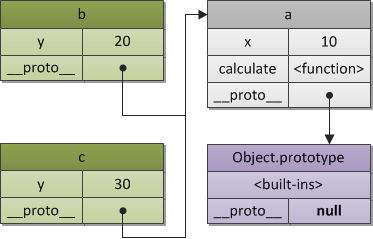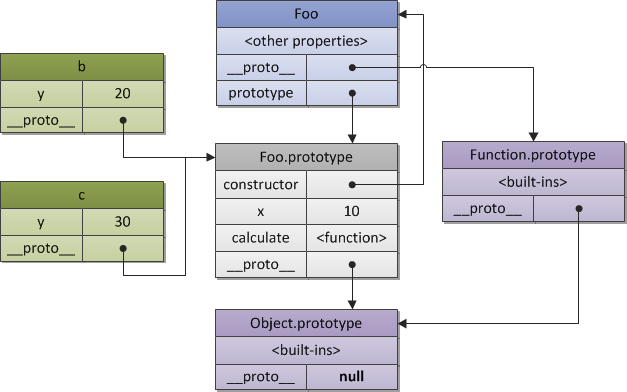JavaScript. The core.
Read this article in: Japanese, German (version 2), Arabic, Russian, French, Chinese.
This note is an overview and summary of the “ECMA-262-3 in detail” series. Every section contains references to the appropriate matching chapters so you can read them to get a deeper understanding.
Intended audience: experienced programmers, professionals.
We start out by considering the concept of an object, which is fundamental to ECMAScript.
An object
ECMAScript, being a highly-abstracted object-oriented language, deals with objects. There are also primitives, but they, when needed, are also converted to objects.
An object is a collection of properties and has a single prototype object. The prototype may be either an object or the null value
Let’s take a basic example of an object. A prototype of an object is referenced by the internal [[Prototype]] property. However, in figures we will use __<internal-property>__ underscore notation instead of the double brackets, particularly for the prototype object: __proto__.
For the code:
var foo = {
x: 10,
y: 20
};
we have the structure with two explicit own properties and one implicit __proto__ property, which is the reference to the prototype of foo:

Figure 1. A basic object with a prototype.
What for these prototypes are needed? Let’s consider a prototype chain concept to answer this question.
A prototype chain
Prototype objects are also just simple objects and may have their own prototypes. If a prototype has a non-null reference to its prototype, and so on, this is called the prototype chain.
A prototype chain is a finite chain of objects which is used to implement inheritance and shared properties.
Consider the case when we have two objects which differ only in some small part and all the other part is the same for both objects. Obviously, for a good designed system, we would like to reuse that similar functionality/code without repeating it in every single object. In class-based systems, this code reuse stylistics is called the class-based inheritance — you put similar functionality into the class A, and provide classes B and C which inherit from A and have their own small additional changes.
ECMAScript has no concept of a class. However, a code reuse stylistics does not differ much (though, in some aspects it’s even more flexible than class-based) and achieved via the prototype chain. This kind of inheritance is called a delegation based inheritance (or, closer to ECMAScript, a prototype based inheritance).
Similarly like in the example with classes A, B and C, in ECMAScript you create objects: a, b, and c. Thus, object a stores this common part of both b and c objects. And b and c store just their own additional properties or methods.
var a = {
x: 10,
calculate: function (z) {
return this.x + this.y + z;
}
};
var b = {
y: 20,
__proto__: a
};
var c = {
y: 30,
__proto__: a
};
// call the inherited method
b.calculate(30); //
c.calculate(40); //
Easy enough, isn’t it? We see that b and c have access to the calculate method which is defined in a object. And this is achieved exactly via this prototype chain.
The rule is simple: if a property or a method is not found in the object itself (i.e. the object has no such an own property), then there is an attempt to find this property/method in the prototype chain. If the property is not found in the prototype, then a prototype of the prototype is considered, and so on, i.e. the whole prototype chain (absolutely the same is made in class-based inheritance, when resolving an inherited method — there we go through the class chain). The first found property/method with the same name is used. Thus, a found property is called inherited property. If the property is not found after the whole prototype chain lookup, then undefined value is returned.
Notice, that this value in using an inherited method is set to the original object, but not to the (prototype) object in which the method is found. I.e. in the example above this.y is taken from b and c, but not from a. However, this.x is taken from a, and again via the prototype chain mechanism.
If a prototype is not specified for an object explicitly, then the default value for __proto__ is taken — Object.prototype. Object Object.prototype itself also has a __proto__, which is the final link of a chain and is set to null.
The next figure shows the inheritance hierarchy of our a, b and c objects:

Figure 2. A prototype chain.
Notice: ES5 standardized an alternative way for prototype-based inheritance using Object.create function:
var b = Object.create(a, {y: {value: 20}});
var c = Object.create(a, {y: {value: 30}});
You can get more info on new ES5 APIs in the appropriate chapter.
ES6 though standardizes the __proto__, and it can be used at initialization of objects.
Often it is needed to have objects with the same or similar state structure (i.e. the same set of properties), and with different state values. In this case we may use a constructor function which produces objects by specified pattern.
Constructor
Besides creation of objects by specified pattern, a constructor function does another useful thing — it automatically sets a prototype object for newly created objects. This prototype object is stored in the ConstructorFunction.prototype property.
E.g., we may rewrite previous example with b and c objects using a constructor function. Thus, the role of the object a (a prototype) Foo.prototype plays:
// a constructor function
function Foo(y) {
// which may create objects
// by specified pattern: they have after
// creation own "y" property
this.y = y;
} // also "Foo.prototype" stores reference
// to the prototype of newly created objects,
// so we may use it to define shared/inherited
// properties or methods, so the same as in
// previous example we have: // inherited property "x"
Foo.prototype.x = 10; // and inherited method "calculate"
Foo.prototype.calculate = function (z) {
return this.x + this.y + z;
}; // now create our "b" and "c"
// objects using "pattern" Foo
var b = new Foo(20);
var c = new Foo(30); // call the inherited method
b.calculate(30); //
c.calculate(40); // // let's show that we reference
// properties we expect console.log( b.__proto__ === Foo.prototype, // true
c.__proto__ === Foo.prototype, // true // also "Foo.prototype" automatically creates
// a special property "constructor", which is a
// reference to the constructor function itself;
// instances "b" and "c" may found it via
// delegation and use to check their constructor b.constructor === Foo, // true
c.constructor === Foo, // true
Foo.prototype.constructor === Foo, // true b.calculate === b.__proto__.calculate, // true
b.__proto__.calculate === Foo.prototype.calculate // true );
This code may be presented as the following relationship:

Figure 3. A constructor and objects relationship.
This figure again shows that every object has a prototype. Constructor function Foo also has its own __proto__ which is Function.prototype, and which in turn also references via its __proto__ property again to the Object.prototype. Thus, repeat, Foo.prototype is just an explicit property of Foo which refers to the prototype of b and c objects.
Formally, if to consider a concept of a classification (and we’ve exactly just now classified the new separated thing — Foo), a combination of the constructor function and the prototype object may be called as a “class”. Actually, e.g. Python’s first-class dynamic classes have absolutely the same implementation of properties/methods resolution. From this viewpoint, classes of Python are just a syntactic sugar for delegation based inheritance used in ECMAScript.
Notice: in ES6 the concept of a “class” is standardized, and is implemented as exactly a syntactic sugar on top of the constructor functions
as described above. From this viewpoint prototype chains become as an implementation detail of the class-based inheritance: // ES6
class Foo {
constructor(name) {
this._name = name;
} getName() {
return this._name;
}
} class Bar extends Foo {
getName() {
return super.getName() + ' Doe';
}
} var bar = new Bar('John');
console.log(bar.getName()); // John Doe
The complete and detailed explanation of this topic may be found in the Chapter 7 of ES3 series. There are two parts: Chapter 7.1. OOP. The general theory, where you will find description of various OOP paradigms and stylistics and also their comparison with ECMAScript, and Chapter 7.2. OOP. ECMAScript implementation, devoted exactly to OOP in ECMAScript.
Now, when we know basic object aspects, let’s see on how the runtime program execution is implemented in ECMAScript. This is what is called an execution context stack, every element of which is abstractly may be represented as also an object. Yes, ECMAScript almost everywhere operates with concept of an object
JavaScript. The core.的更多相关文章
- javascript系列之核心知识点(一)
JavaScript. The core. 1.对象 2.原型链 3.构造函数 4.执行上下文堆栈 5.执行上下文 6.变量对象 7.活动对象 8.作用域链 9.闭包 10.this值 11.总结 这 ...
- 清除css、javascript及背景图在浏览器中的缓存
在实际项目开发过过程中,页面是上传到服务器上的.而为了减少服务器的压力,让用户少加载,浏览器会将图片.css.js缓存到本地中,以便下次访问网站时使用.这样做不仅减少了服务器的压力,并且也减少了用户的 ...
- 【Web前端】清除css、javascript及背景图在浏览器中的缓存
在实际项目开发过过程中,页面是上传到服务器上的.而为了减少服务器的压力,让用户少加载,浏览器会将图片.css.js缓存到本地中,以便下次访问网站时使用.这样做不仅减少了服务器的压力,并且也减少了用户的 ...
- JS学习:JavaScript的核心
分享到 分类 JS学习 发布 ourjs 2013-12-02 注意 转载须保留原文链接,译文链接,作者译者等信息. 作者: JeremyWei 原文: JavaScript The ...
- term "JavaScript"
在Web浏览器上下文中理解的总称“JavaScript”包含几个非常不同的元素. 其中一个是核心语言(ECMAScript),另一个是Web API的集合,包括DOM(文档对象模型) JavaScri ...
- JavaScript Objects in Detail
JavaScript’s core—most often used and most fundamental—data type is the Object data type. JavaScript ...
- atitit.闭包的概念与理解attilax总结v2 qb18.doc
atitit.闭包的概念与理解attilax总结v2 qb18.doc 1.1. 闭包(Closure)是词法闭包(Lexical Closure)的简称,是引用了自由变量的函数.1 2. #---- ...
- addEventListener、attachEvent、cancelBubble兼容性随笔
一.前言 1. element.addEventListener(eventType, handler, capture); (1)参数eventType是要注册句柄的事件类型名. (2)参数hand ...
- 如何:对 SharePoint 列表项隐藏 ECB 中的菜单项
可以通过使用功能框架向编辑控制块 (ECB) 菜单添加新的自定义操作.但是,您不能使用此方法进行相反的操作,即隐藏现有的 ECB 菜单项,因为它们是通过使用 ECMAScript(JavaScript ...
随机推荐
- 理解JavaScript中的事件路由冒泡过程及委托代理机制
当我用纯CSS实现这个以后.我开始用JavaScript和样式类来完善功能. 然后,我有一些想法,我想使用Delegated Events (事件委托)但是我不想有任何依赖,插入任何库,包括jQuer ...
- python关于字符串的操作
#-*- coding:utf-8 -*-#Author:gxli#字符串的操作name=' zhangsan,lisi,wangwu '#分割操作name=name.split(',')print( ...
- java rest框架jersey数组单记录问题解决
JAVA数据接口采用jersey技术,可以返回xml,json等格式,可以根据客户端请求accept,如:Application/json,Application/xml 来得到不同的接口数据,非常好 ...
- 用MSBuild和Jenkins搭建持续集成环境(1)
http://www.infoq.com/cn/articles/MSBuild-1 你或其他人刚刚写完了一段代码,提交到项目的版本仓库里面.但等一下,如果新提交的代码把构建搞坏了怎么办?万一出现编 ...
- git简单入门
git简单入门 标签(空格分隔): git git是作为程序员必备的技能.在这里就不去介绍版本控制和git产生的历史了. 首先看看常用的git命令: git init git add git comm ...
- 通过手机Web实现手机摇一摇的功能
经常我们玩微信都会用到查到附近的人,都是在app上实现手机摇一摇的功能.现在,我们将此技术搬移到手机web上,供大家学习,主要是用到HTML5的重要特性就是DeviceOrientation:官方文档 ...
- sudo su 提示没有配置JDK environment
sudo su 提示没有配置JDK environment 最近工作遇到一问题,我通过SecureCRT远程登录服务器,部署web应用.将变更文件替换后,我需要切换到root用户,重启Tomcat.所 ...
- nginx简单反向代理和负载均衡(ubuntu)
nginx简单反向代理与负载均衡 环境:三台ubuntu 12.04.5 虚拟机 均装有nginx 1.1.19 以下u1(192.168.240.129) ,u2(192.168.240.13 ...
- ubuntu mysql 使用
环境:ubuntu 12.04.5 mysql-server-5.5 安装:sudo apt-get install mysql-server-5.5 (服务端 第一台虚拟机) sudo apt ...
- bzoj 3295 树套树
比较裸,可以有好多的优化,比如根本没有删除的点没有加在树套树中的必要,预处理 出来每个不会被删除的值可以减少不少时间,也可以写成树状数组套平衡树,都会快很多 /******************** ...
